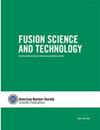Modeling the Tokamak Exhaust Processing System in a Commercial Simulator for Process Monitoring Purposes
IF 0.9
4区 工程技术
Q3 NUCLEAR SCIENCE & TECHNOLOGY
引用次数: 0
Abstract
AbstractNuclear fusion depends on tritium breeding and self-sufficiency. Tritium represents a hazard due to its radioactivity and migration properties. Because of these difficulties, ITER, the largest fusion experiment so far, relies on a conservative static procedure to monitor the tritium inventory. Future commercial fusion plants can avoid operation halts if a dynamic monitoring strategy proves itself valid. Tritium plant models have been developed for this kind of monitoring and analysis task, but sensor accuracy and reliability are an issue still to be addressed, and the path to dynamic monitoring remains unclear. The present work shows the modeling procedure of the Tokamak Exhaust Processing system in a commercial simulator, Aspen HYSYS, to reproduce the inventories, streams, process conditions, and compositions of this subsystem during operation. The model is verified in a steady-state scenario using data from the available literature. A demonstration of such a tritium plant subsystem shows meaningful value for several reasons. First, this process has not been modeled before in commercial dynamic simulators, which are typically used in the process industry. It will also allow new stakeholders to participate in future fusion-related projects. Second, it will play a key role in industry-like tritium process monitoring, in which the new model will act as a digital twin of the plant. Data-driven diagnostics can be fueled by model data, helping engineers to generate additional data that could otherwise be expensive to get directly from the plant. For these reasons, models will represent an essential part of a dynamic monitoring system, necessary for feasible fusion projects.Keywords: Tritium processingtokamak exhaust processingdynamic modelingAspen HYSYSisotopic database AcronymsADS:=Atmosphere Detritiation SystemANS:=Analytical SystemDF:=Decontamination FactorDS:=Detritiation SystemGDC:=Glow Discharge CleaningISS:=Isotope Separation SystemNBI:=Neutral Beam InjectorPERMCAT:=PERMeator CATalytic reactorPI:=proportional-integralSDS:=Storage and Delivery SystemSRK:=Soave-Redlich-KwongTEP:=Tokamak Exhaust ProcessingTLK:=Tritium Laboratory KarlsruheVDS:=Vent Detritiation SystemWDS:=Water Detritiation SystemDisclosure StatementNo potential conflict of interest was reported by the author(s).Notesa DF is defined for the TEP system as the ratio between input tritium flow rate to output tritium flow rate.[Citation10]Additional informationFundingThis work has been possible thanks to co-funding of the Centro para el Desarrollo Tecnológico Industrial of the Spanish Ministry of Science and Innovation [IDI-20200750] and to the Industrial Doctorates Plan of the Government of Catalonia [2018 DI 0048].托卡马克排气处理系统在商业模拟器中的过程监控建模
摘要核聚变依赖于氚的增殖和自给自足。氚因其放射性和迁移特性而具有危险性。由于这些困难,迄今为止最大的核聚变实验ITER依靠保守的静态程序来监测氚库存。如果动态监测策略被证明是有效的,未来的商业核聚变电厂可以避免运行中断。针对这种监测和分析任务,已经开发了氚厂模型,但传感器的准确性和可靠性仍然是一个有待解决的问题,动态监测的路径仍然不明朗。本研究展示了托卡马克排气处理系统在商用模拟器Aspen HYSYS中的建模过程,以重现该子系统在运行期间的库存、流、工艺条件和组成。利用现有文献中的数据在稳态情景中验证了该模型。由于几个原因,这种氚厂子系统的演示显示出有意义的价值。首先,这个过程之前还没有在商业动态模拟器中建模,而商业动态模拟器通常用于过程工业。它还将允许新的利益相关者参与未来的融合相关项目。其次,它将在工业氚过程监测中发挥关键作用,在工业氚过程监测中,新模型将充当工厂的数字双胞胎。数据驱动的诊断可以由模型数据推动,帮助工程师生成额外的数据,否则直接从工厂获取这些数据的成本会很高。由于这些原因,模型将是动态监测系统的重要组成部分,对于可行的融合项目是必要的。关键词:氚处理;托卡马克废气处理;动态建模;aspen hysys同位素数据库AcronymsADS:=大气脱水系统ans:=分析系统df:=去污因子ds:=脱水系统gdc:=辉光放电清洗iss:=同位素分离系统nbi:=中性束注入器permcat:=渗透催化反应器pi:=比例积分sds:=存储和输送系统srk:= sove - redlich - kwongtep:=托卡马克废气处理tlk:=氚实验室KarlsruheVDS:=排气脱水SystemWDS:=Water detriation system披露声明作者未报告潜在的利益冲突。注:DF在TEP系统中被定义为输入氚流量与输出氚流量之比。[引文10]其他信息资金这项工作得以实现,得益于西班牙科学与创新部的Centro para el Desarrollo Tecnológico工业中心[id -20200750]和加泰罗尼亚政府的工业博士计划[2018 DI 0048]的共同资助。
本文章由计算机程序翻译,如有差异,请以英文原文为准。
求助全文
约1分钟内获得全文
求助全文
来源期刊

Fusion Science and Technology
工程技术-核科学技术
CiteScore
2.00
自引率
11.10%
发文量
60
审稿时长
3 months
期刊介绍:
Fusion Science and Technology, a research journal of the American Nuclear Society, publishes original research and review papers on fusion plasma physics and plasma engineering, fusion nuclear technology and materials science, fusion plasma enabling science technology, fusion applications, and fusion design and systems studies.
 求助内容:
求助内容: 应助结果提醒方式:
应助结果提醒方式:


